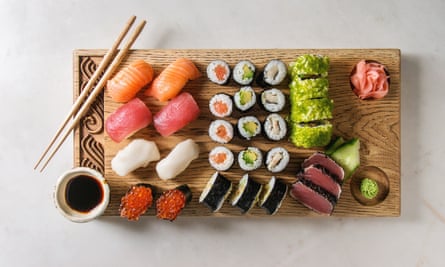There is little at Shiogama seafood market to suggest that Japanese consumers could one day be deprived of their favourite seafood – from giant crab’s legs simmering in a winter nabe hotpot to spheres of salmon roe resting on a bed of rice wrapped in nori seaweed.
Stalls heave with huge sides of bluefin tuna, expertly transformed into more manageable portions by knife-wielding workers, while early-morning shoppers pause to inspect boxes of squid, flounder and sea pineapples landed only hours earlier.
Despite the bounty on display in this small port town, a growing body of scientific evidence – backed up by anecdotes from fishermen – points to a bleak future for Japanese cuisine as a result of the climate emergency.
Miki Seino, a Shiogama stallholder, flashes a look of weary recognition when the Observer points at her display of sanma – or Pacific saury – an autumn delicacy in Japan, where it is often served grilled or raw as sushi and sashimi.
“The catches are smaller, and the fish are thinner than they were a few years ago. We have heard about how rising sea temperatures are affecting catches here in Tohoku,” said Seino, referring to the region in north-east Japan. “And they are a lot more expensive now.”
Japan’s fisheries agency has cited changes in the marine environment due to global heating as the cause of smaller catches of saury, as well as squid, salmon and other staples of the Japanese diet.
The emergence of warm water masses in the Kuroshio – a warm north-easterly ocean current off the east coast of Japan – has pushed saury’s spawning migratory path further offshore, where food is less plentiful, resulting in depleted stocks and poorer quality fish.
Dr Aiko Yamauchi, vice-president of Seafood Legacy, a Japan-based consulting firm that supports sustainable seafood businesses and environmental groups, says catches of species venerated by the Japanese have been in steep decline since 2014.
It is possible, Yamauchi said, “that other fish species will experience poor catches similar to or worse than at present. We are very concerned that if this happens, the majority of Japanese fisheries, which supply around half of the country’s seafood, will be exposed to serious damage.”

Hundreds of miles south-west of Shiogama, fishing communities in Kochi prefecture are fretting over large catches of unusually fatty skipjack tuna, a local delicacy often eaten raw.
Kochi’s arc-shaped bay has traditionally been a fertile fishing ground, but bigger fish could be a warning rather than a blessing. The average surface temperature of the bay in winter has risen by 2C over the past four decades – meaning there is more food for the fish. But in the long term, warmer waters could spell disaster, preventing mineral-rich water from rising to the surface, resulting in fewer smaller fish to feed on – and fewer skipjack tuna.
Shin-ichi Ito, a professor at Tokyo University’s Atmosphere and Ocean Research Institute, said rising sea temperatures meant some species, including yellowtail and Spanish mackerel, were now being found in unusual locations.
“These species are being caught further north than they were 10 years ago, and this could be the result of climate change,” he said, adding that other hardy perennials of Japanese cuisine were under threat, including kelp on the northernmost main island of Hokkaido and, near the mouth of Tokyo Bay, seaweed used to make nori.
Not even sushi’s pungent accompaniment is safe, according to experts. They say the increasing frequency and severity of storms is destroying wasabi farms, while rising temperatures are threatening farmers’ ability to cultivate the delicate vegetable, which can only grow in water kept at a consistent 10-15C throughout the year.
Salmon, another sushi staple, is also at risk, Ito said. “Fish are unable to control their own body temperatures … the only option is for them to migrate northwards.” Simulations of sea temperature changes, he added, suggest that salmon could disappear from the waters around Hokkaido in Japan’s far north in a matter of decades.
after newsletter promotion
“These changes will inevitably affect the Japanese diet as some species disappear, but they also mean we will see more invasive species,” he said.
A future in which crustaceans have disappeared from the menu seems unthinkable, but ocean acidification risks making that a reality. A rise in seawater temperature makes it more difficult for shellfish and crustaceans to form calcium carbonate, adversely affecting the growth of popular seafood such as scallops, clams and oysters, as well as crabs and shrimps.
“Most people can’t grasp how serious these problems are because they feel they will occur far into the future after they are long gone,” Ito said. “What happens in the year 2100 isn’t their problem … but we are at a tipping point now.”
Jun Hoshikawa has witnessed changes to the local catch first-hand from his home on Yakushima island, a Unesco world natural heritage site of natural beauty where he has lived for four decades. He is seeing fewer yellowtail, but bigger numbers of fish that used to be found further south. “The northern shift in habitats is likely to become a wider trend for many marine species as a result of rising sea temperatures”, said Hoshikawa, a former executive director of Greenpeace Japan.
“Unfortunately, most Japanese people haven’t yet noticed the subtle changes in the seafood they’re eating, although I expect that to change in the coming years.”
As mid-morning approaches, Shiogama market is filling up with regular customers and tourists who can mix and match ingredients to create their own kaisen donburi – raw seafood on rice, seasoned with soy sauce and wasabi.
The dish is a celebration of local produce that changes with the passing months. Seino, though, wonders for how long. “We are selling fish in the autumn and winter that we used to have only in the summer,” she said. “It feels like the seasons don’t matter any more.”
Reuters contributed reporting
